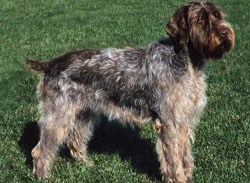Wirehaired Pointing Griffons are medium-sized dogs with wiry, hard coats that come in brown, white & brown, roan, steel & brown, or white & orange. Their double coats are coarse and protect them in rough weather. The breed's outer coat is straight, wiry, and medium length, while the undercoat is fine and thick. These dogs have a prominent mustache and eyebrows, large eyes, medium-size ears, and well open nostrils. Wirehaired Pointing Griffons measure 20 to 24 inches tall at the shoulder and weigh 45 to 70 pounds.
Although they are focused and independent in the field, Griffons very much love family time indoors.
Quick, outgoing, and intelligent, Griffons make good family pets. They crave human companionship, are devoted to family members, and are even-tempered and trainable. These dogs enjoy being house dogs, but they do need lots of time outside and daily exercise to remain mentally and physically healthy.
This breed is sometimes referred to as Korthals Griffons in various countries around the world.
Not suited for apartment life, Griffons need time outdoors to run and play. A house with a large, fenced yard is ideal for this breed. Daily exercise in the form of open running, jogging, or vigorous play is important. Swimming is a favorite activity. Keeping them busy will prevent noisy and destructive behaviors; the Wirehaired Pointing Griffon tends to act out when bored.
Although they are focused and independent in the field, Griffons very much love family time indoors. In fact, these devoted dogs will become lonely and depressed if left alone for long periods. As long as they get some attention and affection, they are happy to lie around, relaxing on the couch or watching television with their human family members.
These dogs are amiable, eager to please, and have a great sense of humor. They make excellent companion animals for families with older children, and they are generally friendly around other dogs and pets. However, unless Griffons are raised with cats, they may view them as prey. These dogs should never be left unsupervised around unfamiliar animals. Wirehaired Pointing Griffons make good watchdogs.
Wirehaired Pointing Griffons suffer from relatively few genetic health problems and tend to be a healthy breed. Of course, this is not a guarantee that any individual dog will be free of health concerns. Purchasing or adopting a Griffon puppy from a reputable source who keeps medical and family history records is a good first step in ensuring a healthy adult dog.
Congenital hip dysplasia is known to affect Wirehaired Pointing Griffons. This condition is a common skeletal disease in dogs that leads to loss of function of the hip joints, potentially limiting mobility. The breed is also prone to ear infections and certain eye conditions, including entropion and ectropion. These problems are manageable with professional care.
Wirehaired Pointing Griffons typically live 12 to 14 years, provided they receive routine veterinary checkups, proper nutrition, daily exercise, and timely canine vaccinations.
Easy to train, Wirehaired Pointing Griffons love learning and are highly intelligent. They aren't known for misbehaving and they're good at following directions. These dogs respond best to praise and other forms of positive reinforcement. Generally, Griffons need only voice commands and hand signals for direction and to stay in line.
Any inappropriate behaviors that develop, such as digging, chewing, or excessive barking, generally cease if attention is increased. These dogs need to feel loved and benefit from a healthy outlet for pent-up energy. Regular time outdoors is also beneficial.
A well-socialized Griffon is confident, calm, and tolerant as an adult. Early socialization is the key to preventing many behavioral problems. Puppy kindergarten is an excellent place to start, but socialization should continue throughout life for the greatest benefits. Older dogs will do well with frequent walks around town on a leash, time at the dog park, and visits to local businesses and neighbors' homes.
The Wirehaired Pointing Griffon's coat may look challenging to care for, but that is far from the truth. To maintain a healthy and attractive coat, brushing is necessary only two or three times each week. Hand stripping is also important to remove dead hair. This can be done every four to six months. These dogs shed little. To help prevent ear problems, the hair inside the ear canal should be plucked regularly.
Griffons don't need frequent baths. In fact, bathing these dogs a lot is counterproductive. A gentle canine shampoo will wash away stinky, sticky, and harmful substances from the coat without drying or irritating the skin. Rinsing thoroughly after swimming in chlorine, saltwater, or algae is very important. These dogs have a water-repellent coat that dries quickly.
To avoid painful snags, the breed's nails should be clipped every week or two, and the teeth need daily brushing to prevent tooth decay, bad breath, and gum disease. Additionally, the ears need cleaning every week to remove excess ear wax. Signs of ear infection, such as odor, redness, and discharge, should be reported to a veterinarian right away.
Dogs resembling Wirehaired Pointing Griffons are believed to have existed for a long time, but their exact origins remain uncertain. Modern history of the breed has been documented in detail, though.
Eduard Korthals, a Dutchman and avid hunter, developed today's breed. Korthals wanted a dog able to hunt over a variety of terrain, so he started a breeding program designed to create a new sporting breed. He crossed Griffon-types with other European dogs, including various pointers, spaniels, and retrievers. It took him less than two decades to develop and write the standard for the Wirehaired Pointing Griffon.
The breed first came to the United States in 1887, and it quickly became a popular companion animal. Due to his contribution to the breed, these dogs are still known as Korthals Griffons throughout much of the world.
The American Kennel Club officially recognized the Wirehaired Pointing Griffon in 1887.

